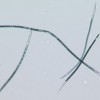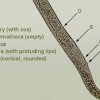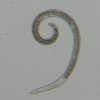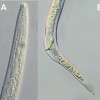 Among the most destructive plant-parasitic nematodes to a wide range of plants, Belonolaimus longicaudatus damages plant roots. When the plants cannot take up water and nutrients from the soil, they become stunted, wilt, and with severe infestation, die. Florida is considered to be the point-of-origin for Belonolaimus longicaudatus and therefore this nematode exhibits a great deal of diversity in morphology, host preference, and genetics in our region. This 6-page fact sheet was written by W. T. Crow, and published by the UF Department of Entomology and Nematology, March 2015. (Photo W. T. Crow, UF/IFAS)
Among the most destructive plant-parasitic nematodes to a wide range of plants, Belonolaimus longicaudatus damages plant roots. When the plants cannot take up water and nutrients from the soil, they become stunted, wilt, and with severe infestation, die. Florida is considered to be the point-of-origin for Belonolaimus longicaudatus and therefore this nematode exhibits a great deal of diversity in morphology, host preference, and genetics in our region. This 6-page fact sheet was written by W. T. Crow, and published by the UF Department of Entomology and Nematology, March 2015. (Photo W. T. Crow, UF/IFAS)
http://edis.ifas.ufl.edu/in1080
Tag: Tylenchida
Amaryllis Lesion Nematode, Pratylenchus hippeastri Inserra et al., 2006 (Nematoda: Tylenchida: Pratylenchidae) (EENY546/IN975)
 Amaryllis lesion nematode is an important nematode pest of amaryllis in Florida. It reduces plant vigor, flower yield, and bulb size. As the nematodes tunnel through the root, the damaged cells die and collapse, forming lesions on the exterior and the interior of the root tissue. This 4-page fact sheet was written by William T. Crow, and published by the UF Department of Entomology and Nematology, January 2013.
Amaryllis lesion nematode is an important nematode pest of amaryllis in Florida. It reduces plant vigor, flower yield, and bulb size. As the nematodes tunnel through the root, the damaged cells die and collapse, forming lesions on the exterior and the interior of the root tissue. This 4-page fact sheet was written by William T. Crow, and published by the UF Department of Entomology and Nematology, January 2013.
http://edis.ifas.ufl.edu/in975
Spiral Nematode, Helicotylenchus pseudorobustus (Steiner, 1941) Golden, 1956 (Nematoda: Tylenchida: Hoplolaimidae) (EENY544/IN973)
 Spiral nematodes of the genus Helicotylenchus are among the most ubiquitous plant-parasitic nematodes worldwide. Helicotylenchus pseudorobustus is a species common in Florida and the southeastern United States and is frequently found associated with turfgrasses and other grass hosts in the region. On most plants, it is not considered particularly damaging, but recent research has shown that this species suppresses growth of certain turfgrass hosts. Seashore paspalum, a turfgrass used in tropical and subtropical regions, is particularly susceptible to infestation. This 4-page fact sheet was written by William T. Crow, and published by the UF Department of Entomology and Nematology, January 2013.
Spiral nematodes of the genus Helicotylenchus are among the most ubiquitous plant-parasitic nematodes worldwide. Helicotylenchus pseudorobustus is a species common in Florida and the southeastern United States and is frequently found associated with turfgrasses and other grass hosts in the region. On most plants, it is not considered particularly damaging, but recent research has shown that this species suppresses growth of certain turfgrass hosts. Seashore paspalum, a turfgrass used in tropical and subtropical regions, is particularly susceptible to infestation. This 4-page fact sheet was written by William T. Crow, and published by the UF Department of Entomology and Nematology, January 2013.
http://edis.ifas.ufl.edu/in973
Burrowing Nematode Radopholus similis (Cobb, 1893) Thorne, 1949 (Nematoda: Secernentea: Tylenchida: Pratylenchidae: Pratylenchinae) (EENY542/IN969)
 The burrowing nematode is the most economically important nematode parasite of banana in the world. Infection causes toppling disease of banana, yellows disease of pepper and spreading decline of citrus. These diseases are the result of burrowing nematode infection destroying root tissue, leaving plants with little to no support or ability to take up water and translocate nutrients. Because of the damage that it causes to citrus, ornamentals and other agricultural industries, worldwide, burrowing nematode is one of the most regulated nematode plant pests. This 5-page fact sheet was written by Nicholas Sekora and William T. Crow, and published by the UF Department of Entomology and Nematology, November 2012.
The burrowing nematode is the most economically important nematode parasite of banana in the world. Infection causes toppling disease of banana, yellows disease of pepper and spreading decline of citrus. These diseases are the result of burrowing nematode infection destroying root tissue, leaving plants with little to no support or ability to take up water and translocate nutrients. Because of the damage that it causes to citrus, ornamentals and other agricultural industries, worldwide, burrowing nematode is one of the most regulated nematode plant pests. This 5-page fact sheet was written by Nicholas Sekora and William T. Crow, and published by the UF Department of Entomology and Nematology, November 2012.
http://edis.ifas.ufl.edu/in969